local_phone
WHY HAIR LOSSING
It is necessary to note that 82% of women essentially don’t have relations with bald men.Hair loss – alopecia, is unfortunately the bitter fate of many men and women, and significantly affects their psycho-emotional health. Statistics show that bald men are 30% less successful in their jobs, and 64% less successful in their personal lives.
Why hair lossingThere are several types of alopecia characterized by different reasons for their development: alopecia areata, diffused, androgenic, cicatricial (after traumas and burns). Androgenic baldness is encountered most often (“male type”) which afflicts to some degree almost a third of the male population of our planet, ranging from 20-60 years old. Androgenic alopecia is also encountered in women.

The reason for the development of androgenic baldness is the destructive effect of the male hormone testosterone and its derivatives upon the hair follicles located in the lobe and crown areas of the head (androgen-dependent zone). Under the influence of male hormones – androgens – sensitive hair follicles gradually decrease in size, move closer to the skin’s surface, lose the ability to produce healthy hair, atrophy, and finally dissolve. In their place develops connective tissue, which does not produce further follicles. Regardless of the fact that these hormones exist in all males, hair loss occurs only in individuals having a genetic pre-disposition.
Eunuchs don’t bald!
Due to the irreversibility of the process of androgenic baldness, medical treatment of such alopecia is not effective – hair does not grow without follicles. At the present time, the only effective method for treating androgenic and cicatricial alopecia in the entire world is the transplantation of one’s own hair.
Signs of beginning hair loss include:
change of hair color in the androgen-dependent zone (hypopigmentation)
thinning of hair in the androgen-dependent zone
decrease in the speed of hair growth (normal 1cm per month)
increased oiliness of hair (seborea)
Norwood classification of androgenic alopecia
ANDROGENETIC ALOPETIA
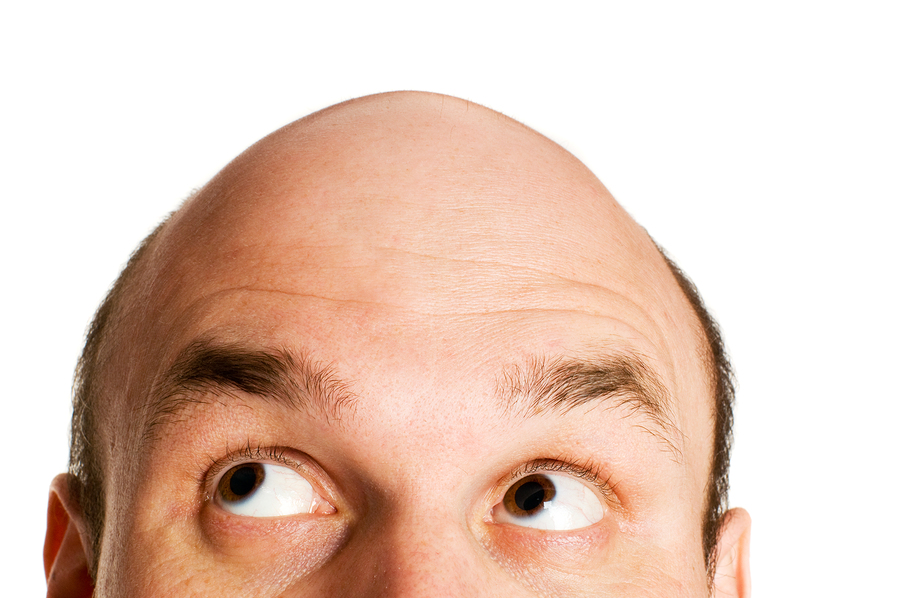
Hair loss – alopecia, is unfortunately the bitter fate of many men and women, and significantly affects their psycho-emotional health. Statistics show that bald men are 30% less successful in their jobs, and 64% less successful in their personal lives.
It is necessary to note that 82% of women essentially don’t have relations with bald menThere are several types of alopecia characterized by different reasons for their development: alopecia areata, diffused, androgenic, cicatricial (after traumas and burns). Androgenic baldness is encountered most often (“male type”) which afflicts to some degree almost a third of the male population of our planet, ranging from 20-60 years old. Androgenic alopecia is also encountered in women.
The reason for the development of androgenic baldness
The reason for the development of androgenic baldness is the destructive effect of the male hormone testosterone and its derivatives upon the hair follicles located in the lobe and crown areas of the head (androgen-dependent zone). Under the influence of male hormones - androgens - sensitive hair follicles gradually decrease in size, move closer to the skin’s surface, lose the ability to produce healthy hair, atrophy, and finally dissolve. In their place develops connective tissue, which does not produce further follicles. Regardless of the fact that these hormones exist in all males, hair loss occurs only in individuals having a genetic pre-disposition.
Eunuchs don’t bald!
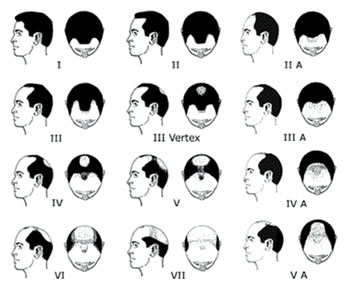
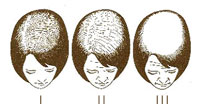
Due to the irreversibility of the process of androgenic baldness, medical treatment of such alopecia is not effective – hair does not grow without follicles. At the present time, the only effective method for treating androgenic and cicatricial alopecia in the entire world is the transplantation of one’s own hair.
Signs of beginning hair loss include:
change of hair color in the androgen-dependent zone (hypopigmentation)
thinning of hair in the ndrogen-dependent zone
decrease in the speed of hair growth (normal 1cm per month)
increased oiliness of hair (seborea)
DIFFUZE ALOPECIA
Diffusive Alopecia (DA) is characterized in men and women by intensive and uniform falling-out of hair from the whole surface of hair part of head after failure of biological program for growth of hair due to any harmful influences.
Diffusive Alopecia has two forms: telogen and anagen.
In case of the most widespread telogen form up to 80% of hair follicles move to telogen (rest) phase ahead of time in order to “hide” from the unfavorable conditions produced in the body. In this stage separation of hair from its root is occurred and hair is ready to leave the skin within the first possible occasions; washing, combing and etc.
Frequently, hair starts to fall-out in an intensive manner after several weeks or even months from the appearance of the provocative reason that is resulted in alopecia. This is explained by the fact that within the mentioned period recovery of biological program for growth of hair is made and new hair begins to grow from the follicles, from where hair was separated and due to this reason old hair emerges on the surface. Accordingly, falling-out of hair in large number during diffusive alopecia represents a good signal indicating that the reason causing failure of growth of hair have not existed any more and hair follicles have returned to their ordinary life cycle. During this phase of the disease edge of new hair is noticeable along hair line.
Falling-out of hair often occurs from not only head but body either. The intensity of falling-out is slowly decreased and ultimately it is ceased within several weeks or a year after disappearance of provocative reasons producing alopecia.
Telogen form of diffusive alopecia is caused by the following:
emotional stress;
acute infectious and heavy chronicle diseases, surgical operations;
diets accompanied with deficiency of proteins;
shortage of some microelements in the body, such as; ferrum, zinc and selenium;
hypo and hyper avitaminosis, namely; disorder of vitamin A balance;
Frequent and prolonged administration of antibiotics, antidepressant and neuroleptic medicines and anticancer drugs.
Prolonged application of hormonal contraceptive means, especially from preceding generation containing increased proportion of hormones;
Failure of function of thyroid gland.
Anagen form of diffusive alopecia is developed due to influence of factors on the body and hair follicles, in particular, stronger and more fast-acting ones and as a result of this hair follicles do not manage to move into rest phase and start to fall-out immediately at anagen (growth) phase in a more intensive manner than it happens in case of telogen form. Such factors are: radioactive radiation, chemotherapy, poisoning by strong toxic substances. In most cases after elimination of provocative reasons producing diffusive alopecia, hair is restored completely and destruction of hair follicles is not occurred. Additional care for hair resulted in growth of more healthy and stronger hair than it was before. Sometimes color and structure of hair is changed (curly hair is altered into straight one and vice versa).
In rare cases chronicle form of diffusive alopecia is developed, the reason of this disease is unknown. It is seen in women aged 30-60, and characterized by reiteration periodically for several years and in the initial stage of this from intensive falling-out of hair is occurred. It does not cause total baldness and is limited with falling-out of hair at certain level.
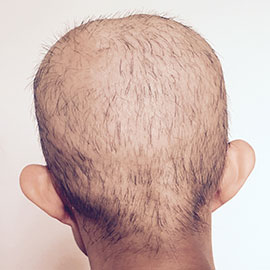
CICATRICAL ALOPECIA
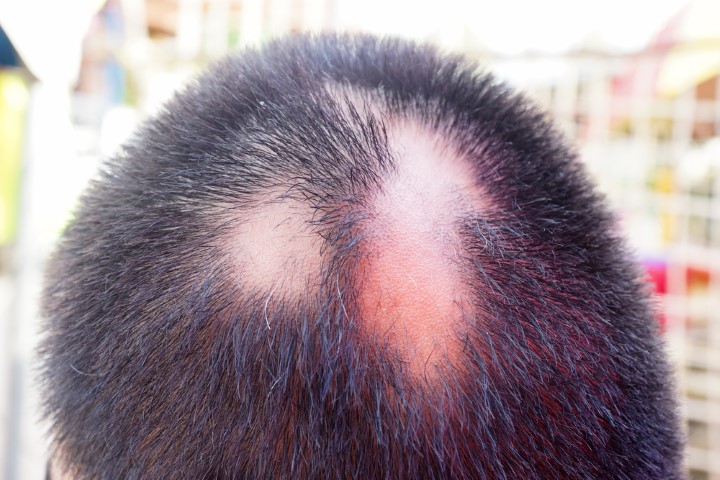
Cicatricial Alopecia is defined as hair loss associated with damage to the hair follicles that leads to scar tissue and permanent baldness. You can be affected by a variety of medical conditions that can cause injury and destruction of hair follicles. Some of these conditions may be associated with symptoms such as itching or irritation or soreness, but with others you can lose hair and develop scarring without knowing that it is going on. Sometimes you will have a bald spot or area of hair loss detected by your hair stylist without your knowing that it was there. This condition has become more common over the past 10-15 years especially related to more frequent practices of using hair extensions and bonding glues on the scalp. There are three main contributing factors to cicatricial alopecia (or scarring alopecia) which cause female baldness.
Causes of Cicatricial Alopecia
Trauma, infection and various skin diseases may injure the hair follicle resulting in localised areas of scarring and bald patches in which there are no visible follicles; this is called ‘cicatricial alopecia’.
Trauma: Hair can be pulled out by tight curlers or certain hair styles, especially black women’s hair styles, sometimes resulting in permanently thinned areas (traction alopecia). The scalp can also be injured by heat (hair dryers), or chemicals (perming solutions or bleach or glues or dyes).
Infections that may cause cicatricial alopecia include Staphylococcal folliculitis or boils , and animal ringworm infection ( tinea capitis ).
Skin diseases that may cause cicatricial alopecia include: central centrifigual scarring alopecia (CCSA), folliculitis decalvans , lichen planopilaris , frontal fibrosing alopecia , alopecia mucinosa , discoid lupus erythematosus , sarcoidosis, cicatricial pemphigoid, alopecia neoplastica, and scleroderma . Scarring hair loss of unknown cause is known as pseudopelade.
ALOPECIA AREATA
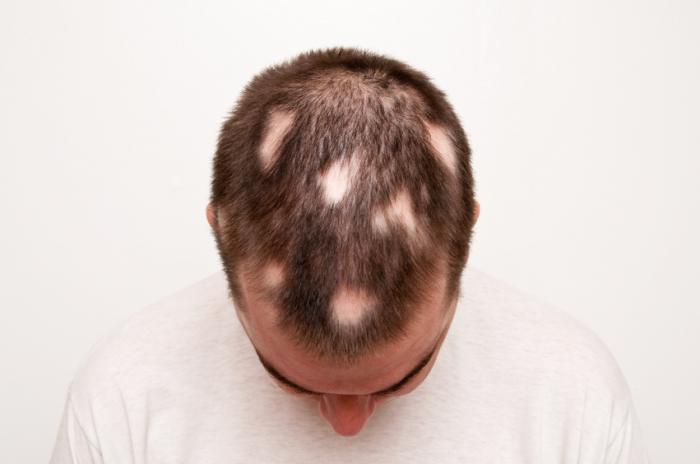
Alopecia Areata is a form of hair loss, usually from the scalp, although it can affect other areas of the body. The hair loss mostly remains limited to the scalp but in certain cases it can extend to eyebrows, eyelashes, facial hair (beard, moustache), nasal hair and give rise to bald spots anywhere in the body.
Alopecia Areata is a common condition which arises largely due to a mix of immunological and hormonal factors. Alopecia Areata can affect both men and women and it is not uncommon to see children affected with this disorder. Approximately 2% of the general population worldwide suffers from Alopecia Areata. We come across many children with Alopecia Areata.
Understanding Alopecia Areata
The hair is made up of a protein called keratin which is also the main constituent of nails. A specialized structure inside the skin called ‘Papilla' produces the hair as shown in the figure. The papilla is surrounded by a sac-like structure called the ‘Hair follicle' which also surrounds rest of the hair root within the skin. The part of the hair outside the skin surface is called as shaft.
Alopecia Areata is considered to be an auto-immune condition in which the immune system of the body (which protects the body from bacteria and viruses) mistakenly attacks the hair follicles and destroys them. This leads to hair loss in the affected area.
The commonest presentation of Alopecia Areata is appearance of bald patches on the scalp. In most cases, hair falls out in small, round patches about the size of a small coin. The patient may have single or multiple such patches. In some cases these patches may remain static, whereas in some cases the patches may spread to involve larger areas of the scalp. In some cases, hair loss is more extensive. Although it is not very common, the disease can progress to cause total loss of hair on the head (Alopecia Areata totalis) or complete loss of hair on the head, face, and rest of the body (Alopecia Areata universalis).
Types of Alopecia Areata:
-Alopecia Areata monolocularis: In this condition there is a single bald spot on the scalp.
-Alopecia Areata subtotalisis: In this condition there are multiple bald spot on the scalp.
-Alopecia Areata totalis: In this condition, the patient loses all the hair on the scalp.
-Alopecia Areata universalis: In this condition, all body hair, including pubic hair, is lost.


